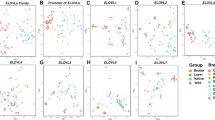Abstract
Peroxisome proliferator-activated receptor α (PPARA) is involved in fatty acid oxidation by upregulating the expression of acyl-coenzyme A oxidase and carnitine palmitoyltransferase. In this study, PPARA gene variations in four chicken breeds (Guyuan, Wenchang, Tibetan, and Hisex) were detected by PCR-SSCP and DNA sequencing. The results indicated six genotypes (AA-EF). When compared with the PPARA reference sequence (GenBank accession no. AF163809), the nucleotide sequences of genotypes AA, BB, AB, and CC revealed silent mutations in the three Chinese breeds. The nucleotide sequences of genotypes DD and EF in Hisex showed several frame-shift mutations, implying variations involving five alleles of the PPARA gene in chicken breeds. In addition, the distribution of genotype frequency within the PPARA gene was significantly different in the four breeds studied, implying that this locus would probably be an effective marker in marker-assisted selection for layer, meat-and-egg, and broiler breeds.



Similar content being viewed by others
References
Adam R, Arnault I, Bao YM (1998) Effect of ischemic preconditioning on hepatic tolerance to cold ischemia in the rat. Transpl Int 11:168–170
Bünger L, Forsting J, McDonald KL (2003) Long-term divergent selection on fatness in mice indicates a regulation system independent of leptin production and reception. FASEB J 17(1):85–87
Dietz RE, Hall JB, Whittier WD (2003) Effects of feeding supplemental fat to beef cows on cold tolerance in newborn calves. Anim Sci 81:885–894
Ding ST, Li YC, Nestor KE, Velleman SG, Mersmann HJ (2003) Expression of turkey transcription factors and acyl-coenzyme oxidase in different tissues and genetic populations. Poult Sci 82:17–24
Diot C, Douaire M (1999) Characterization of a cDNA sequence encoding the peroxisome proliferator activated receptor α in the chicken. Poult Sci 78:1198–1202
Griffin HD, Guo K, Windsor D, Butter SC (1992) Adipose tissue lipogenesis and fat deposition in leaner broiler chickens. J Nutr 122:363–368
Kgwatalala PM, Nielsen MK (2004) Performance of mouse lines divergently selected for heat loss when exposed to different environmental temperatures. II. Feed intake, growth, fatness, and body organs. J Anim Sci 82:2884–2891
Lammoglia MA, Bellows RA, Grings EE (1999) Effects of prepartum supplementary fat and muscle hypertrophy genotype on cold tolerance in newborn calves. J Anim Sci 77:2227–2233
Lan XY, Pan CY, Chen H, Zhang CL, Zhang AL, Zhang L, Li JY, Lei CZ (2007) An MSPI PCR-RFLP detecting a single nucleotide polymorphism at alpha-lactalbumin gene in goat. Czech J Anim Sci 52:138–142
Meng H, Wang GH, Wang QG, Zhao JG, Gu ZL, Wang YX, Li H (2002) Studies of single nucleotide polymorphism of PPAR gene and its associations with fattiness trait in chicken. Acta Genetica Sinica 29:ta119–ta123
Meng H, Wang YX, Li H (2004) Characterization of tissue expression of peroxisome proliferator activated receptors in the chicken. Acta Genet Sin 31:682–687
Meng H, Li H, Zhao JG, Gu ZL (2005) Differential expression of peroxisome proliferator-activated receptors alpha and gamma gene in various chicken tissues. Domest Anim Endocrin 28:105–110
Palmer CAN, Hsu MH, Griffin KJ (1998) Peroxisome proliferator activated receptor-α expression in human liver. Mol Pharmacol 53:14–22
Sambrook J, Russell DW (2002) Molecular cloning: a laboratory manual, 3rd edn. Science Press, Beijing. Translated by Huang Pei Tang
Sun HS, Anderson LL, Yua TP, Kima KS, Klindt J, Tuggle CK (2002) Neonatal Meishan pigs show POU1F1 genotype effects on plasma GH and PRL concentration. Anim Reprod Sci 69:223–237
Xie XL, Wang D, Wang H (2005) Relationship between genotype of PPARA and body fat traits in AA broiler line. Acta Veter Zoo Tech Sin 36:1261–1264
Zhang CL, Wang YH, Chen H, Lan XY, Lei CZ (2007) Enhance the efficiency of single-strand conformation polymorphism analysis by short polyacrylamide gel and quick low-background silver staining. Anim Biochem 365:286–287
Acknowledgments
This study was supported by the National Natural Science Foundation of China (no. 30460097) and the Youth Foundation of Northwest A&F University. We thank X. L. Liu and C. Huang at the Hainan chicken-breeding farm (P.R. China) for their excellent care of the Wenchang chicken. We also acknowledge the workers at the Guyuan, Wenchang, and Tibetan chicken-breeding farms in Ningxia, Hainan, and Tibet provinces of China for helping to collect blood samples.
Author information
Authors and Affiliations
Corresponding author
Rights and permissions
About this article
Cite this article
Zhang, J.Q., Chen, H., Sun, Z.J. et al. Genetic Variation of the Peroxisome Proliferator-Activated Receptor α Gene (PPARA) in Chickens Bred for Different Purposes. Biochem Genet 48, 465–471 (2010). https://doi.org/10.1007/s10528-009-9329-0
Received:
Accepted:
Published:
Issue Date:
DOI: https://doi.org/10.1007/s10528-009-9329-0




